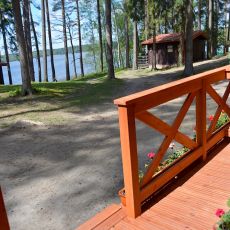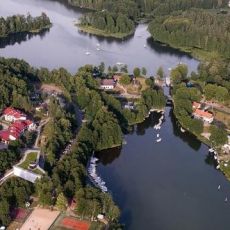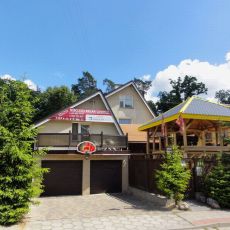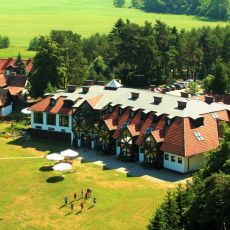Accommodation in Ruciane Nida
Among the forests of the Pisz Forest, on the lakes Nidzkie, Guzianka Wielka, Guzianka Mała and Bełdany, there is the South Gate of Masuria, commonly known as Ruciane-Nida. Unusual charming geographical location as well as catchy, intriguing name is one of the most important factors contributing to the fact that this small Masurian town is known, even if only from hearing, to every Pole. Why are Ruciane Nida's accommodations so popular?
Tourist popularity of the town, which in 1966 entered the structure of just what the city was founded, began at the end of the nineteenth century, when it began to expand communication routes connecting the larger cities of the region. It was the neighborhood of Pisz, Mikołajki and Mrągowo that made the villages hidden among the lakes, which in time were included in the area of Ruciane-Nida, became one of the most prominent and already known in the interwar period business cards of the Land of the Great Masurian Lakes. It is from the visit in Ruciane-Nida that all those who come to its regions from the south of the country start their adventure with the most water region of Poland. It is the stay in this small town that makes tourists who fall in love with the tranquility and contact with nature fall in love with Masuria and return to their hospitable thresholds in search of a respite from everyday worries.
Numerous accommodations in Ruciane Nida await tourists who decide to rest in this beautiful town. The main advantages of the town are the lakes located within it. This is where the biggest attractions of the town are associated: built between Guzianka Mala and Bełdanami sluice chamber which annually uses several tens of thousands of boats, a marina from which you can sail on a ship "Sea Shipping" not only on the Nidzkie lake, but also Bełdany, Śniardwy or Mikołajskie, PTTK Yacht Marina, numerous baths and centers adapted for sports. Those who want to explore the area can set out on a walking or cycling tour one of the unusually picturesque nature trails, which visitors follow not only with the history of the region, but also with the beautiful Masurian nature. On their route, you can reach the originally Protestant church of the Church of Our Lady of Mercy in Ostrobramska, which was extremely important during the Second World War. Zdzisław Boroński, "Borejszowki" - a wooden house from the beginning of the 20th century, a house in the shape of a boat, the accommodation of Hermann Göring in Szeroki Bór or Leśniczówka Pranie where there is the Museum of Konstanty Ildefons Gałczyński. Admiring the beauty of the surrounding lakes, you can see two about five hundred years old, almost thirty meters oaks (one of them is almost 550 cm circumference, the second about 320 cm), curved in the shape of lyre over two hundred years, measuring 33 meters of pine and numerous habitats of wild animals, which seasoned tourists like in the marshy, lakeside surroundings of one of the most beautiful and at the same time the most cozy towns in Masuria, which is undoubtedly Ruciane-Nida.
Wojnowo
Located in the heart of the Pisz Forest, Wojnowo is one of the most exotic places on the map of Masuria. Prussia, of which Masuria was a part, for over 400 years was a country where the dominant religion was evangelicalism. The Russian Old Believers who appeared in the Piska Forest in the 1830s brought to the landscape of the Evangelic Masuria not only a new denomination, but also a peculiar eastern color. The heritage they left behind is today a valuable image of the religious and moral culture of the Prussian Old Prussians.
Old-believers (also called old Believers, Filipinos) were forced to leave Russia in the 17th century after they refused to accept the reforms of the Russian Orthodox Church conducted by Patriarch Nikon. Many of them settled in today's Suwałki region, from where they came to Prussia in the 1930s. On the basis of the Hermitage of the Hermitage founded on the lake, a monastery was established in Wojnowo in 1847 - initially male, from 1885 a female. The monastery ceased to function in 2006 with the death of the last nun. Currently, the Museum of Icon and Culture of Old Believers operates here. In Wojnowo we will also see a cemetery of Old Believers and a brick molenna (house of prayer) of philippines and a wooden Orthodox church - both buildings were built in the 1920s.
Browse accommodation Ruciane Nida from VisitON and discover what is meant by a holiday among the green lungs of Poland








